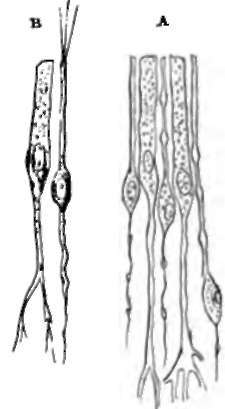164. The Olfactory Nerves
Description
This section is from the book "Animal Physiology: The Structure And Functions Of The Human Body", by John Cleland. Also available from Amazon: Animal Physiology, the Structure and Functions of the Human Body.
164. The Olfactory Nerves
The Olfactory Nerves consist each of a brush of filamerits of the soft and nucleated variety, and ramify beneath the mucous membrane of the upper and middle turbinated bones and the ethmoidal part of the nasal septum; and in this, which is termed the olfactory region, the mucous membrane of the nose, called also the Schnei-derian or pituitary membrane, is softer and smoother, and has the mucous glands smaller than they are in the lower part of the nasal fossę. The olfactory mucous membrane is likewise distinguished by being clothed with a non-ciliated columnar epithelium. But between the ordinary columnar cells are scattered slender nucleated bodies, each of which is in continuity with a filament of olfactory nerve, and in birds and amphibia is furnished with a single hair or a bundle of fine cilia. These are called olfactory cells; and we are led to believe that the wonderfully and impon-derably minute odorous particles drawn into the nasal fossę in inspiration affect their extremities, and, through them, the olfactory nerves.

Fig. 110. Olfactory Cells, with the epithelial cells between which they lie; both with deep connections. A, Human. B, From frog. After Schultze and Frey.
Continue to:
- prev: 162. Smell
- Table of Contents
- next: 165. Taste
